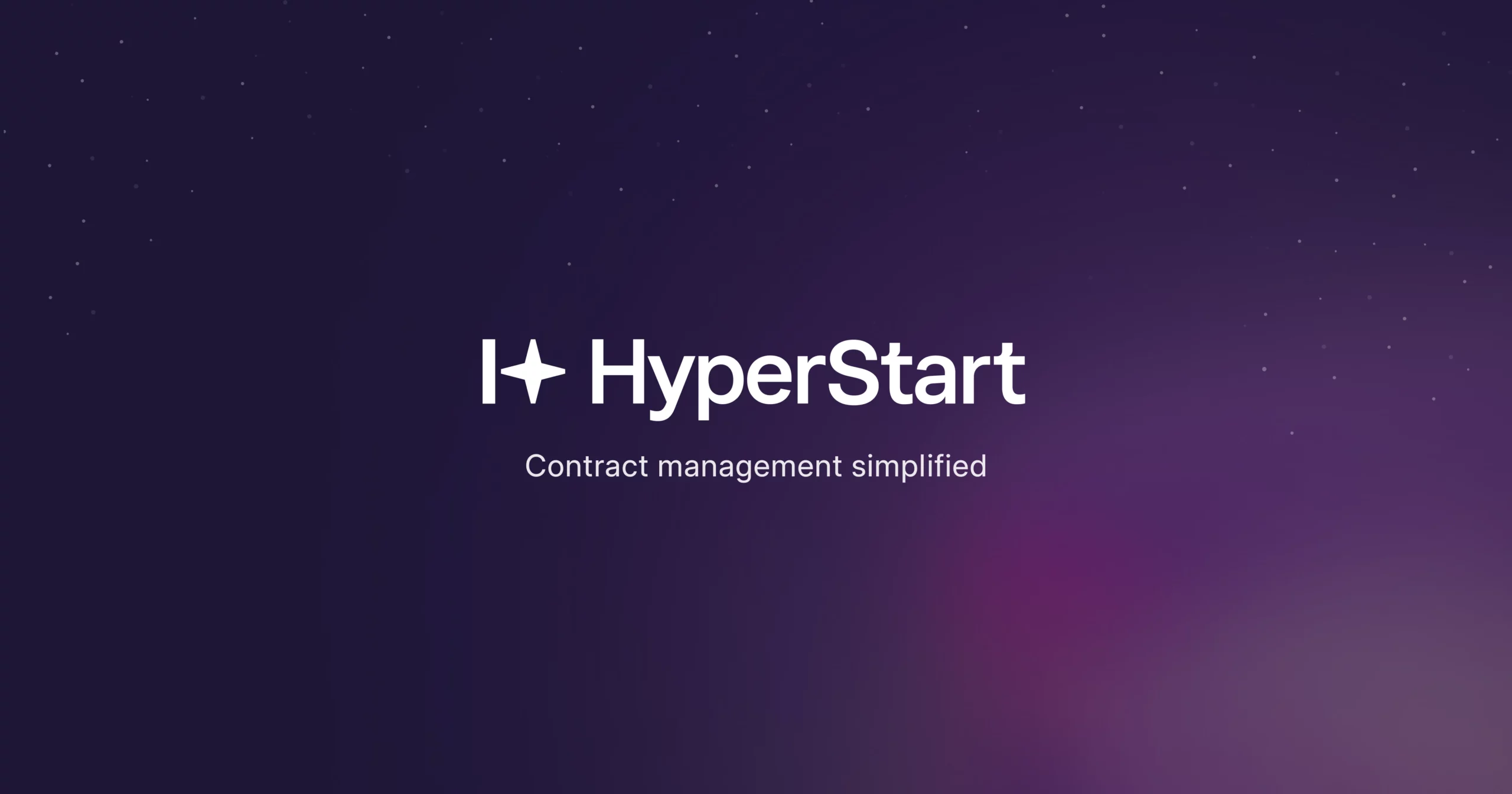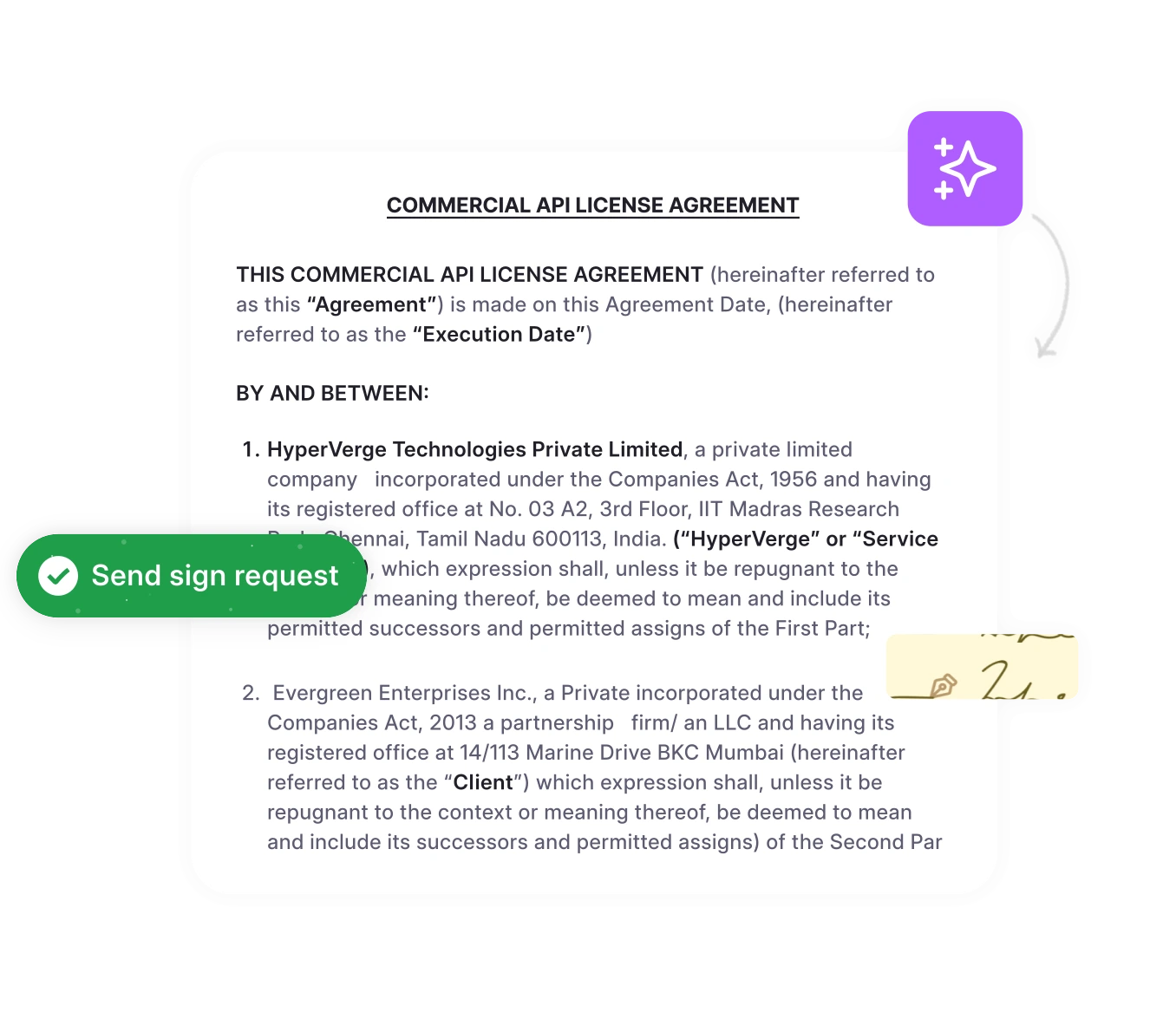Many businesses face unexpected disruptions that trigger force majeure clauses in their contracts. However, a common challenge is quickly identifying which agreements contain these protections.
The problem isn’t the unforeseen events themselves—it’s not knowing what your contracts say about them. Legal teams often spend weeks manually reviewing scattered contracts, delaying critical decisions, and increasing risk exposure.
Force majeure clauses serve as vital safeguards, allowing companies to pause obligations without penalties during crises. Understanding how to draft and manage these clauses effectively can prevent costly contract disputes and enhance your risk management strategy.
This guide covers the legal essentials of force majeure, tips for drafting clear clauses, and how modern contract lifecycle management tools help companies stay prepared and responsive.
What is a force majeure clause?
A force majeure clause is a contractual provision that relieves parties from performing obligations when extraordinary circumstances beyond their control make performance impossible or impractical.
Key elements of force majeure clauses:
- Unforeseeable events beyond the parties’ control
- Events make performance impossible or impractical
- Proper notice and mitigation efforts are required
- Specific triggering events must be listed
The term originates from French law, meaning “superior force” or “greater force.” Also known as “Act of God” clauses, these provisions serve as contractual safety nets when extraordinary events disrupt normal business operations.
The force majeure clauses gained prominence during the 20th century as global commerce became more complex and interdependent. Unlike common law doctrines of impossibility or frustration, force majeure clauses allow parties to define specific triggering events and procedures upfront.
Legal Authority:
Force majeure clauses vary significantly by jurisdiction. For instance, New York courts interpret these clauses narrowly, requiring specific events to be explicitly listed. In contrast, California courts may allow broader interpretations under certain circumstances.
Defining a force majeure clause is the first step; however, ensuring it is legally enforceable requires certain critical elements. Let’s explore what these essential components are.
What are the essential elements of enforceable force majeure clauses?
For force majeure clauses to provide meaningful protection, they must meet specific legal requirements. Courts scrutinize these provisions carefully, and poorly drafted clauses often fail when businesses need them most.
1. Unforeseeable event
The triggering event must be beyond reasonable prediction at the time of contract creation. Courts consider industry standards, historical precedent, and available information when determining foreseeability.
Example: A hurricane in Florida during hurricane season may not qualify as unforeseeable, while an earthquake in a non-seismic region likely would.
2. Impossibility or impracticality
Performance must be genuinely prevented, not merely more expensive or complicated. The standard is objective impossibility, not subjective hardship.
The court ruled that increased costs alone don’t constitute impossibility, justifying force majeure invocation.
— Case Briefs
3. Proper notice and mitigation
The affected party must provide timely notification and demonstrate reasonable faith efforts to minimize the impact. Failure to follow contractual notice procedures often invalidates force majeure claims.
Required notice typically includes:
- Description of the force majeure event
- Expected duration of delay
- Specific impact on contractual obligations
- Mitigation efforts undertaken or planned
Understand contract risks clearly
HyperStart’s AI scans contracts to identify force majeure clauses and highlights potential gaps or ambiguous language before they cause disruption.
Book a DemoKnowing the elements helps draft enforceable clauses, but understanding their importance in protecting parties during unforeseen events highlights their true value.
What is the importance of a force majeure clause?
Force majeure clauses serve as essential risk management tools that protect businesses from financial and legal exposure during extraordinary events. Understanding their importance helps legal teams make informed decisions about contract protection.
1. Business continuity protection
Force majeure clauses provide a legal safety net when unforeseeable events make contract performance impossible. Without these provisions, parties may face breach of contract claims even when circumstances beyond their control prevent performance.
Consider this scenario: A manufacturing company contracts to deliver specialized equipment by December 31st. A massive earthquake destroyed their facility in November. Without a force majeure clause, they could face breach of contract liability despite the natural disaster being completely outside their control.
2. Financial risk mitigation
- Breach of contract damages exceeding contract value
- Legal costs ranging from $50,000 to $500,000+ for contract disputes
- Lost business relationships due to adversarial legal proceedings
- Reputation damage affecting future partnerships
Effective force majeure clauses limit financial exposure during crisis events. They can prevent costly litigation, reduce damage claims, and preserve business relationships when extraordinary circumstances disrupt normal operations.
The financial impact is significant. Companies without adequate force majeure protection often face:
3. Strategic business planning
Force majeure clauses enable more predictable risk allocation between contracting parties. They allow businesses to plan for contingencies while maintaining reasonable performance expectations under normal circumstances.
Smart force majeure planning includes:
- Risk assessment by contract type and counterparty
- Industry-specific event identification
- Clear notice and mitigation procedures
- Balanced termination rights protecting both parties
4. Legal compliance and audit readiness
Well-drafted force majeure clauses demonstrate proactive risk management to stakeholders, investors, and regulatory bodies. They show that legal teams consider extraordinary events in contract planning rather than relying solely on general legal doctrines.
To leverage this protection effectively, it’s crucial to recognize exactly when a force majeure clause applies and how it triggers contract relief.
When does the force majeure clause come into effect?
Force majeure clauses activate when specific triggering events occur and meet defined criteria. Understanding activation requirements prevents misuse and ensures proper invocation when legitimate circumstances arise.
1. Three-part legal test
For force majeure clauses to take effect, events must typically satisfy three requirements:
- Unforeseeable event: The event must be beyond reasonable prediction at contract formation
- Performance impossibility: The event must make performance genuinely impossible, not merely more difficult or expensive
- Beyond party control: The event must be outside the affected party’s ability to prevent or control
2. Specific event triggers
Modern force majeure clauses enumerate specific events rather than relying on general language. Common triggers include:
- Natural disasters: Earthquakes, hurricanes, floods, wildfires when they directly impact performance ability
- Government actions: New laws, regulations, sanctions, or emergency orders that prevent contract performance
- Infrastructure failures: Power grid failures, internet outages, transportation system disruptions lasting more than specified periods
- Cybersecurity events: Cyber attacks requiring system shutdown, data breaches affecting operational capacity
- Public health emergencies: Pandemics, epidemics declared by recognized health authorities requiring operational changes
Manage liabilities and obligations with precision
HyperStart flags inconsistent or risky force majeure provisions, helping you safeguard your contracts and reduce dispute risks.
Book a DemoTiming matters, but so does precision in drafting. Here’s how to create force majeure clauses that clearly define risks, responsibilities, and remedies.
How to draft effective force majeure clauses
Creating force majeure clauses that actually protect your business requires careful attention to legal requirements, industry-specific risks, and practical implementation considerations. Follow this systematic approach to draft provisions that courts will enforce and that provide meaningful protection.
1. Define triggering events specifically
Avoid vague language like “circumstances beyond reasonable control.” Instead, create comprehensive lists tailored to your industry:
Technology industry example:
Force majeure events specifically include: cyber attacks on critical systems, third-party cloud service outages exceeding 4 hours, government-mandated encryption changes, critical software vulnerabilities requiring immediate patches, and internet infrastructure failures affecting service delivery.
Best Practice: Include both specific events and a narrow catch-all provision: “other events that render performance objectively impossible despite reasonable mitigation efforts.”
2. Establish clear notice requirements
Specify exact procedures to prevent disputes over notice adequacy:
Notice requirements:
- Written notice within 10 business days of the event occurrence
- Delivery via email and certified mail to designated contract contacts
- Include: event description, performance impact, expected duration, and planned mitigation efforts
- Follow-up notices every 30 days until the event concludes
The UK Supreme Court clarified that a party affected by a force majeure event is not required to accept an alternative method of performance that differs from the contract’s express terms, even if it offers a practical workaround. The dispute arose when US sanctions, deemed a force majeure event, prevented RTI from making payments in US dollars as required.
RTI offered to pay in euros and cover conversion costs, but MUR Shipping refused and suspended supply. The Court ruled in MUR Shipping’s favour, emphasising that the contract’s strict currency requirement meant it was not obliged to accept alternative payment arrangements.
— Myerson
3. Include meaningful mitigation obligations
Courts expect parties to minimize force majeure impacts. Define specific mitigation requirements:
Examples of mitigation requirements:
- Secure alternative suppliers or service providers
- Implement workaround solutions where possible
- Maintain regular communication with affected counterparties
- Document all mitigation efforts with supporting evidence
4. Address duration and termination rights
Establish clear boundaries for force majeure suspension periods:
Duration and Termination:
- Force majeure suspends performance obligations only for directly affected contract elements
- If the event continues beyond 120 days, either party may terminate with 60 days written notice
- Partial performance is required for unaffected obligations
- Payment obligations for completed work remain in effect
Without a properly drafted force majeure clause, parties face increased legal uncertainty and potential disputes. Let’s consider the implications when this protection is missing.
What happens when the force majeure clause is absent?
When contracts lack force majeure clauses, parties face a harsh reality: they must rely on unpredictable common law doctrines that courts are reluctant to apply. This legal gap often proves costly when extraordinary events disrupt business operations.
The problem with common law doctrines: Without contractual force majeure provisions, legal teams must argue for protection under three restrictive common law theories. Each carries significant limitations and uncertain outcomes.
1. Impossibility doctrine: an extremely high bar
- Physical impossibility: Factory completely destroyed, raw materials permanently unavailable, or essential services terminated
- Legal impossibility: Government action makes performance illegal(not just regulated differently)
- Death or incapacity: Loss of essential personnel whose skills cannot be replaced
Courts require objective impossibility—performance must be genuinely impossible, not merely difficult or expensive. The standard is unforgiving:
2. Frustration of purpose: rarely successful
This doctrine applies when a contract’s purpose becomes fundamentally frustrated by unforeseen events. Requirements include:
- The original contract’s purpose was completely defeated
- Circumstances radically different from what the parties contemplated
- The event was truly unforeseeable at contract formation
3. Commercial impracticability: limited relief
Performance must become unreasonably burdensome due to unforeseen circumstances. Courts typically require:
- Extreme cost increases: Usually 300-500% above original expectations
- Critical resource unavailability: Essential materials or services are completely unavailable
- Fundamental assumption failure: Basic contract assumptions prove incorrect
Important Limitation: Increased costs alone rarely satisfy this standard. Courts expect businesses to absorb reasonable risk.
Transform the clause review with AI
Simplify complex contract reviews with HyperStart by automating the identification and assessment of key provisions across all agreements.
Book a DemoProper clause management goes beyond drafting—it requires tracking, enforcement, and updates. CLM software provides essential tools to manage force majeure clauses efficiently.
How to manage a force majeure clause with CLM
Managing force majeure clauses becomes simpler and more effective when you use a modern contract lifecycle management (CLM) platform. HyperStart’s AI-powered CLM transforms scattered contract chaos into organized operations, delivering faster contract processing for legal teams. Here are the key benefits of leveraging CLM for force majeure management:
1. Gain instant, centralized visibility
Instead of hunting through scattered files and emails, CLM lets you quickly search your entire contract portfolio for force majeure clauses. This centralized access saves time and reduces risk when you need to act fast during a crisis.
Test HyperStart’s AI search capabilities: Upload 5 of your contracts and see how our AI instantly identifies and extracts key terms.
2. Use AI-powered insights to evaluate clause strength
CLM platforms analyze force majeure language with high accuracy, not just by keyword matching. They score clause effectiveness, highlight weaknesses, and compare your contracts against industry standards to help you improve protections before disruptions occur.
3. Automate critical obligation tracking
CLM systems track important deadlines for notices and responses, monitor triggering events, and maintain complete records of force majeure invocations and related documentation. This contract automation software ensures you never miss vital steps during urgent situations.
See automated deadline management in action: Connect your contracts and experience how HyperStart tracks obligations and deadlines automatically.
4. Standardize and update templates easily
Keep your force majeure language consistent and up to date with centralized template libraries. CLM platforms manage version control and approval workflows, making it simple to incorporate legal updates and evolving risks across all contracts.
5. Enhance proactive risk management
By turning reactive crisis management into proactive monitoring, CLM platforms help your team stay prepared and responsive, transforming force majeure clauses from static legal text into strategic risk tools.
Implementation was very smooth. Using the bulk upload feature, all contracts were integrated into the system within minutes. I was also able to see the AI extracted metadata on the tool immediately, which was impressive.

Mayuri Jaltare
Company Secretary
Proactively manage risk with HyperStart’s AI-powered CLM
Many companies struggle with scattered contracts and manual reviews, risking missed protections during crises.
HyperStart’s AI-powered CLM platform standardizes contract language and review with:
- 80% faster contract processing vs. manual methods
- 94% AI accuracy for clause identification across your entire portfolio
- 2-week implementation vs. months for traditional CLM solutions
Customer Success: LeadSquared’s Transformation
LeadSquared, a marketing automation platform, exemplifies why they chose HyperStart’s centralized contract lifecycle management.
We took demos of around 5 CLM vendors and chose to go with HyperStart. They were the only CLM vendor who had SOC2 compliance and met the criteria of around 22 parameters, which we had evaluated them on.

Om Prakash Pandey
Legal Counsel Head
Results achieved:
Get instant analysis of your contract portfolio. Upload your contracts and see exactly which agreements have force majeure protection and which need strengthening. Book a demo.











